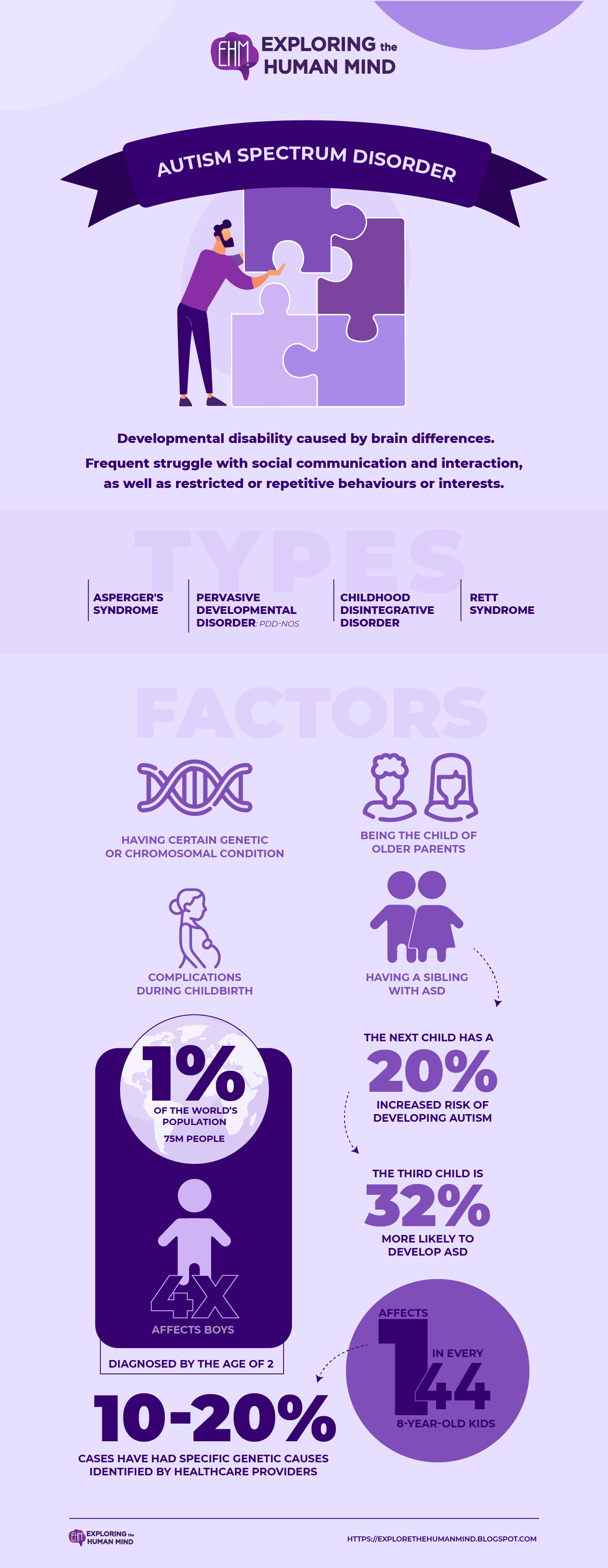Autism Spectrum Disorder: Types and Risks
Types
- Asperger's syndrome
- Pervasive developmental disorder (PDD-NOS)
- Childhood disintegrative disorder
- Rett syndrome
Risk Factors
ASD is caused by a variety of factors. Many different factors have been identified that may increase a child's risk of having ASD, including environmental, biological, and genetic factors. Although we know little about specific causes, evidence suggests that the following factors may increase a child's risk of developing ASD:
- Having a sibling with ASD
- Having certain genetic or chromosomal conditions, such as fragile X syndrome or tuberous sclerosis
- Complications during childbirth
- Being the child of older parents

vectors by Freepick; graphic design by Vadot
ASD appears before the age of three and can last for the rest of a person's life, though symptoms may improve over time. Some children exhibit ASD symptoms within the first year of life. In others, symptoms may not appear until the child is 24 months old or later. Some children with ASD learn new skills and meet developmental milestones until they are 18 to 24 months old, at which point they stop learning new skills or lose those they already have.
ASD affects approximately 1 in every 44 8-year-old children, according to the Centres for Disease Control and Prevention.
Autism is caused by genetic factors. However, only 10% to 20% of cases have had specific genetic causes identified by healthcare providers. Specific genetic syndromes associated with ASD, such as fragile X syndrome, and rare changes in genetic code are examples of these cases.
Autism is a hereditary disorder. When one child is diagnosed with ASD, the next child has a 20% increased risk of developing autism. When the first two children in a family have ASD, the third child is 32% more likely to develop ASD.
According to the Centers for Disease Control and Prevention (CDC), about 1% of the world’s population has autism spectrum disorder – over 75,000,000 people. That may be a large number, but autism spectrum disorder (ASD) features a wide range of symptoms and levels of severity. It doesn’t present in every child the same way.
ASD affects boys four times more than girls and can be reliably diagnosed by the age of two, but children may be diagnosed earlier.
Early detection of ASD allows children to receive the services they require. There is no "cure" for ASD, but there are several interventions that can help children learn important life skills.
Reference:
Signs and Symptoms of Autism Spectrum Disorders. Centers for Disease Control and Prevention. . CDC. (2023, January 11). https://www.cdc.gov/ncbddd/autism/signs.html#:~:text=Autism%20spectrum%20disorder%20(ASD)%20is,or%20repetitive%20behaviors%20or%20interests. CDC. (2022, December 9). What is Autism Spectrum Disorder? Centers for Disease Control and Prevention. https://www.cdc.gov/ncbddd/autism/facts.html
What Is Autism Spectrum Disorder (ASD)? - (2013). Cleveland Clinic. Cleveland Clinic. https://my.clevelandclinic.org/health/diseases/8855-autism 10 Facts about Autism Spectrum Disorder (ASD). (2020, November 4). Hhs.gov. https://www.acf.hhs.gov/ecd/10-facts-about-asd
How Many People are Diagnosed with Autism in the U.S. (2021, January 2). Therapeutic Pathways. https://www.tpathways.org/faqs/how-many-people-have-autism/#:~:text=How%20many%20people%20have%20autism%3F&text=According%20to%20the%20Centers%20for,symptoms%20and%20levels%20of%20severity.






Comments
Post a Comment